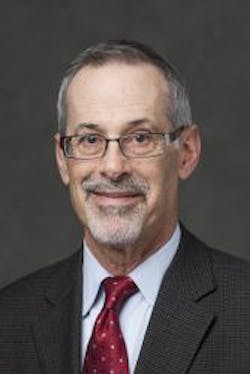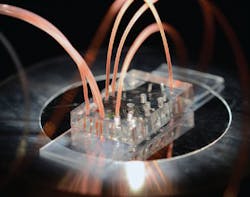Business Forum: Collaboration is key to success in biophotonics

The juncture of higher education and entrepreneurship is especially relevant in biophotonics. Prof. David R. Walt discusses these two universes and how they mutually benefit each other.
Walt is a professor and a Howard Hughes Medical Institute Professor at Tufts University and the scientific founder and a director of both Illumina Inc. and Quanterix Corp. He is a co-chair of the Board on Chemical Sciences and Technology of the U.S. National Academy of Sciences. He is a member of the U.S. National Academy of Engineering, American Academy of Arts and Sciences, a fellow of the American Institute for Medical and Biological Engineering, a fellow of the National Academy of Inventors, and a fellow of the American Association for the Advancement of Science. He received a B.S. in chemistry from the University of Michigan and a Ph.D. in chemical biology from Stony Brook University.
Milton Chang: How did you get into "biophotonics"?
David R. Walt: I was trained in organic chemistry, and for my Ph.D. work, I synthesized adriamycin, a cancer-curing agent, which is still being used today. For my postdoctoral studies, I became interested in using enzymes to catalyze reactions that are difficult for chemists to do. Enzymes are expensive so I learned about enzyme immobilization as a way to use them again after they did their work. When I became a young professor, I was one of a handful of people who knew how to immobilize molecules to surfaces. I was asked to consult for a startup company to attach dyes onto fiber optics to measure pH, CO2, and oxygen in the bloodstream. That company failed but I was hooked on the idea of using optical fibers as sensors. What gets me excited about technology is to create new tools that enable capabilities to make advances that have never been possible.
MC: Where do you see biophotonics going?
DW: Photonics is going to provide a tremendous number of answers to pressing problems in biology, in the clinic, and eventually in a point-of-care setting. Perhaps in 10 years or certainly in 20 years, small devices will be able to do incredible things that require a huge dedicated laboratory today. Such devices are going to be common in the home and will be able to perform complex real-time analysis to monitor your health and be able to do things such as tell you where your food came from, how fresh it is, and whether you need to go to the doctor because you will be able to self-diagnose an infection. No question about it!MC: How do you see your role as a professor?
DW: Our role is to educate. “Professor” is not just a teacher. Professors use their real-life experiences to convey to students their excitement about the field, stories about how discoveries are made, and personalities. They also use their personal experience to profess, to provide philosophy and perspective as opposed to just giving a series of facts and concepts.
MC: And the role of the university?
DW: A university is a place to educate. When a graduate student in their fourth or fifth year really gets cranking, that’s when they should graduate because they can work as an independent researcher; you have educated them. They don’t belong in a university anymore. That’s the epitome of the role of the university in terms of its mission to educate.
A university is also a place to grapple with pressing problems facing society. It is a place where there is a high concentration of brainpower in so many disparate areas—from humanities and political science to engineering and the hard sciences. It is a place where highly educated individuals are willing to work on difficult problems for a very long time. That’s how we can train students to succeed in the real world, by crossing boundaries and talking to people in different departments to really understand the bigger picture of what they are trying to accomplish.
MC: What you said makes a lot of sense. How do you select students with that in mind?
DW: I look for people who are willing to take risks and go outside of their comfort zone. I have a very diverse research lab. I have students from the genetics department, computer science, students trained as physicists, and of course chemists. I tell students to embrace learning from everybody. I always ask a candidate to spend some time in the lab talking to everybody. Then I ask my people if they think this person can work well in the group and has the personality to enhance the group dynamics. I also look for people who are collaborative. We don’t welcome people who come into the lab just wanting to work on their project and do their own thing.
MC: I always say arrogance is our worst enemy, in academia or in business, anywhere!
DW: Absolutely! We can do a better job in conveying that, particularly in Ph.D. programs. Historically, the Ph.D. candidate works by himself or herself on their thesis project; otherwise, it is not considered independent research. This culture is absolutely the opposite of what makes an individual succeed in the commercial world. In a startup company, no one works alone; everyone works as a team to get products out the door. Technologists have to understand the problem and then seek solutions that can come from other disciplines.
MC: That’s a perfect lead-in to entrepreneurship. Tell us about Illumina, one of the companies you founded.
DW: Illumina is the leading company in the world for genetic analysis. It has almost 3500 employees, will have nearly $2 billion in revenue this year, and is providing products that are making a huge difference in the world.
MC: What was it like in the beginning?
DW: I had 10 to 15 patents issued in the fiber-optic-array space before I started the company. It was very clear to me that the technology had a competitive advantage over everything that existed because of the ability to multiplex. In addition, the ease by which we were able to manufacture gave us a very compelling pull in the marketplace.
MC: Any advice for would-be entrepreneurs based on that experience?
DW: The most important lesson is to start a company only when it is ready—not just because you feel you have to do it. The other important thing is the technical founder has to realize that successful companies rely on many people with different backgrounds. We had spectacular financial people, business leaders who were able to identify markets and to come up with a strategy, not only for financing, but were able to develop corporate culture. And we had a tremendous engineering team that we brought in…it is very much a team effort. As the technical founder, your contribution can never be taken away from you, but as an entrepreneur you really have to let the experts drive their area—not you—just because you are the inventor of the technology.
MC: What about Quanterex?
DW: We wanted to show we could count molecules to do analysis of complex biological samples. We have developed a transformative technology to detect things with a thousand-times-higher sensitivity—we are able to count single molecules. There are 70 employees now at Quanterex.
MC: I want to know your vision of biology and medicine going forward.
DW: I certainly think the next breakthrough will be from combining the data that comes from wet science with computational tools. The marriage between science and computation will be transformative. We are at the cusp of making dramatic discoveries on how biological systems operate—to be able to use that knowledge to create tremendous value in healthcare. We are just beginning to see such power with the information coming out of genetic sequencing.
About the Author
Milton Chang
MILTON CHANG of Incubic Management was president of Newport and New Focus. He is currently director of mBio Diagnostics and Aurrion; a trustee of Caltech; a member of the SEC Advisory Committee on Small and Emerging Companies; and serves on advisory boards and mentors entrepreneurs. Chang is a Fellow of IEEE, OSA, and LIA. Direct your business, management, and career questions to him at [email protected], and check out his book Toward Entrepreneurship at www.miltonchang.com.

